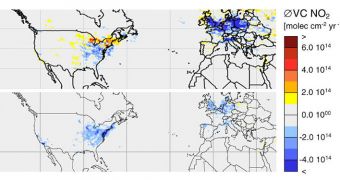According to the conclusions of a new scientific investigation, it would appear that atmospheric nitrogen dioxide levels across much of Europe and the United States have fallen significantly as compared to 15 years ago.
This is excellent news for air quality advocates, and a victory for those interested in a healthy environment. Discovering this trend was made possible only through uninterrupted monitoring of air quality above the two continents.
The fact that nitrogen dioxide levels have decreased is a significant progress, considering that the chemical is an important byproduct of urban pollution. Over the same interval, scientists did not discover a drop in population or urban density over the research areas.
This means that NO2 concentrations decreased by other means than a proportional relation to the number of people that release polluting agents. In fact, scientists say, this particular compound is one of the main pollutants in the lowest layer of the atmosphere, the troposphere.
The first data on NO2 concentrations were collected by the Global Ozone Monitoring Experiment (GOME) instrument on the European Space Agency's (ESA) European Remote-Sensing (ERS-2) satellite. Though the suite was developed to monitor ozone, it proved useful for NO2 studies as well.
Though GOME initiated these measurements in 1995, it was the Sciamachy sensor on ESA's now-defunct Envisat, the OMI suite on the NASA Aura satellite, and the GOME-2 instrument on the MetOp spacecraft that continued this level of intense scrutiny to this day.
Interestingly, these instruments revealed a significant increase in NO2 concentrations in the Middle East and certain parts of Asia, even though levels decreased in Europe and North America.
“The changes observed from space can be explained by two effects: increased use of fossil fuels in evolving economies, leading to increased pollution and improvements in technology – like cleaner cars – leading to reduced pollution,” Andreas Richter explains.
“These changes in pollution levels are surprisingly rapid, and satellites are the only way to monitor them globally. For this, the long-term availability of satellite instruments that can monitor pollution is of key importance,” the expert adds.
Richter holds an appointment as a scientist with the Institute of Environmental Physics, at the University of Bremen, in Germany.

 14 DAY TRIAL //
14 DAY TRIAL //